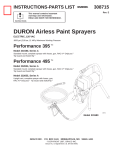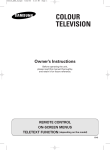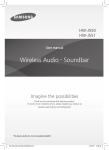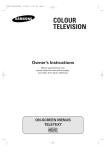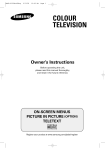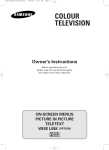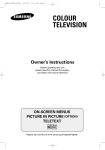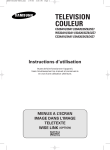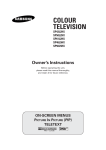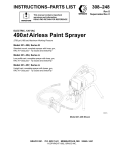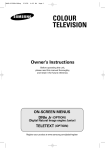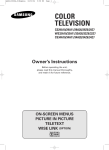Download Samsung CW29A1081G User Manual
Transcript
COLOUR TELEVISION Owner’s Instructions Before operating the unit, please read this manual thoroughly, and retain it for future reference. ON-SCREEN MENUS PICTURE IN PICTURE TELETEXT Safety Instructions ENG ◆ Do not expose the television to extreme temperature conditions or to extreme humidity conditions. ◆ Do not expose the television to direct sunlight and other sources of heat. ◆ Do not expose the television to any liquids. ◆ Never put objects of any kind into the television, and do not place a water-containing vessel on the television. ◆ During a storm conditions (especially when there is lightning) unplug the television from the mains socket and aerial. ◆ Do not step on or twist the power cord. ◆ Do not overload wall outlets or extension cords as this can result in a risk of fire or electric shock. ◆ Please use a soft and dry cloth (not containing volatile matter) when you clean the TV. ◆ If the television is broken, do not try to repair it yourself. Contact qualified service personnel. ◆ If the remote control is not used for a long period of time, remove the batteries and store it in a cool, dry place. ◆ Do not drop the remote control. This device is not for use in industrial environments. Caution CAUTION RISK OF ELECTRIC SHOCK DO NOT OPEN CAUTION: TO PREVENT ELECTRICAL SHOCK, DO NOT REMOVE REAR COVER, NO USER SERVICEABLE PARTS INSIDE. REFER SERVICING TO QUALIFIED SERVICE PERSONNEL. WARNING: TO PREVENT DAMAGE WHICH MAY RESULT IN FIRE OR SHOCK HAZARD. DO NOT EXPOSE THIS APPLIANCE TO RAIN OR MOISTURE. 2 The lightning flash and arrow head within the triangle is a warning sign alerting you of “dangerous voltage” inside the product. The exclamation point within the triangle is a warning sign alerting you of important instructions accompanying the product. ☛ The main voltage is indicated on the rear of the TV set and the frequency is 50 or 60Hz. ENG Contents ◆ FOREWORD ■ ■ Safety Instructions ......................................................................................... Caution .......................................................................................................... 2 2 ◆ CONNECTING AND PREPARING YOUR TELEVISION ■ ■ ■ ■ ■ ■ ■ ■ ■ ■ View of Your Television (depending on the model) ....................................... Infrared Remote Control ................................................................................ Inserting the Batteries in the Remote Control................................................ Connecting to an Aerial or Cable Television Network ................................... Switching Your Television On and Off........................................................... Placing Your Television in Standby Mode ..................................................... Becoming Familiar with the Remote Control ................................................. Plug & Play Feature....................................................................................... Viewing the Demonstration............................................................................ Choosing Your Language.............................................................................. 5 6 7 7 8 8 9 10 11 11 ◆ SETTING THE CHANNELS ■ ■ ■ ■ ■ ■ Storing Channels Automatically..................................................................... Sorting the Stored Channels ......................................................................... Storing Channels Manually............................................................................ Skipping Unwanted Channels ....................................................................... Assigning Names to Channels ...................................................................... Fine Tuning Channel Reception .................................................................... 12 13 14 16 17 18 ◆ USING YOUR TELEVISION (continued) ■ ■ ■ ■ ■ ■ ■ ■ ■ ■ ■ ■ Changing the Picture Standard ..................................................................... Adjusting the Picture Settings........................................................................ Extra Picture Settings (Digital NR / LNA / DNIe / Scan mode).......................................................... Setting the Blue Screen................................................................................. Using the Tilt Control Feature........................................................................ Selecting the Picture Size.............................................................................. Freezing the Current Picture ......................................................................... Changing the Sound Standard ...................................................................... Adjusting the Sound Settings ........................................................................ Selecting the Turbo Sound ............................................................................ Extra Sound Settings (Auto volume / Melody / Pseudo stereo / Virtual surround) ........................... Selecting the Sound Mode (depending on the model) .................................. 3 19 20 21 22 22 23 23 23 24 24 25 26 ENG Contents (continued) ◆ USING YOUR TELEVISION ■ ■ ■ ■ Setting the Sleep Timer ................................................................................. Setting and Displaying the Current Time....................................................... Switching the Television On and Off Automatically ....................................... Viewing the Picture In Picture (PIP) .............................................................. 27 28 29 30 ◆ USING THE TELETEXT FEATURE ■ ■ ■ ■ ■ Teletext Feature ............................................................................................ Displaying the Teletext Information ............................................................... Selecting a Page by Number......................................................................... Using FLOF to Select a Page........................................................................ Storing Teletext Pages .................................................................................. 32 32 33 34 34 ◆ ADDITIONAL INFORMATION ON CONNECTIONS ■ ■ ■ ■ ■ ■ Connecting to the External Input/Outputs...................................................... Connecting to the Audio Output .................................................................... Connecting to the RCA Input......................................................................... Connecting to the S-Video Input.................................................................... Connecting Headphones ............................................................................... Viewing Pictures From External Sources ...................................................... 35 35 36 36 37 37 ◆ RECOMMENDATIONS FOR USE ■ ■ ■ Automatic Degaussing to Remove Colour Patches....................................... Troubleshooting: Before Contacting Service Personnel................................ Wiring the Mains Power Supply Plug (UK Only)............................................ Symbols Press 4 ☛ ➢ Important Note 38 38 39 View of Your Television (depending on the model) ➢ The actual configuration on your TV may be different, depending on your model. ENG Control Panels CW29A10 WS32A10 c a d e f b g a) Remote control sensor e) Menu display b) Standby indicator f) Volume adjustment c) Power On/Off g) Channnmel selection d) Input source selection Connection Panels Rear of the TV Side of the TV Audio Input (R, L) Video Input S-Video Input Headphone connector SCART Audio/ Video Input/Output Monitor Audio Output 75Ω Coaxial Connector for Aerial/Cable Network 5 Infrared Remote Control ENG AUTOMATIC SWITCH-OFF/ TELETEXT STORE STILL PICTURE DNIe ON/OFF/DEMO VCR OR DVD FUNCTIONS; - STOP - REWIND - PLAY/PAUSE - FAST FORWARD TELEVISION STAND-BY PIP PIP FUNCTIONS (OPTION); - PIP ON/OFF - INTERCHANGE THE MAIN AND SUB PICTURE (SWAP) - STILL - SIZE SELECTION (SIZE) - LOCATION SELECTION (LOCATE) - SCAN - SOURCE SELECTION (TV/VIDEO) - CHANNEL SELECTION (P▲/▼) MAKE THE REMOTE CONTROL WORKS FOR TV, VCR, CABLE, DVD PLAYER. DIRECT CHANNEL SELECTION ONE/TWO-DIGIT CHANNEL SELECTION/ TELETEXT PAGE HOLD ➣ The remote control might not be compatible with the TV manufactured by another company. ON-SCREEN DISPLAY/ TELETEXT REVEAL TUNER/CABLE NETWORK SELECTION NEXT CHANNEL/ TELETEXT NEXT PAGE EXTERNAL INPUT SELECTION/ TELETEXT MODE SELECTION (LIST/FLOF) MENU DISPLAY/ PROGRAMME SELECTION BY NAME VOLUME DECREASE TEMPORARY SOUND SWITCH-OFF TELETEXT DISPLAY/ MIX BOTH TELETEXT INFORMATION AND THE NORMAL BROADCAST PICTURE SIZE/ TELETEXT SIZE SELECTION TURBO SOUND SOUND MENU DISPLAY VOLUME INCREASE PREVIOUS CHANNEL\ TELETEXT PREVIOUS PAGE SOUND MODE SELECTION/ TELETEXT SUB-PAGE PICTURE MENU DISPLAY PICTURE EFFECT SELECTION SOUND EFFECT SELECTION FASTEXT TOPIC SELECTION ➢ 6 The performance of the remote control may be affected by bright light. Inserting the Batteries in the Remote Control ENG You must insert or replace the batteries in the remote control when you: ◆ Purchase the television ◆ Find that the remote control is no longer operating correctly 1 Remove the cover on the rear of the remote control by pressing the symbol downwards and then pulling firmly to remove it. 2 Insert two R03, UM4, “AAA” 1.5V or equivalent batteries taking care to respect the polarities: ◆ - on the battery against - on the remote control ◆ + on the battery against + on the remote control 3 Replace the cover by aligning it with the base of the remote control and pressing it back into place. Connecting to an Aerial or Cable Television Network To view television channels correctly, a signal must be received by the set from one of the following sources: ◆ An outdoor aerial ◆ A cable television network ◆ A satellite network 1 In the first three cases, connect the aerial or network input cable to the 75Ω coaxial socket on the rear of the television. 2 If you are using an indoor aerial, you may need to turn it when tuning your television until you obtain a picture that is both sharp and clear. For further details, refer to: ◆ “Storing Channels Automatically ” on page 12 ◆ “Storing Channels Manually” on page 14 Rear of the TV or Cable Television Network 7 Switching Your Television On and Off ENG The mains lead is attached to the rear of your television. ☛ 1 Plug the mains lead into an appropriate socket. ➢ 2 If you have purchased this television in the United Kingdom, refer to page 39 for further instructions on plug wiring. The main voltage is indicated on the rear of the television and the frequency is 50 or 60Hz. Press the “ Result: 3 ” button (On/Off) on the front of the television. The Standby indicator on the front of the television lights up. Press the POWER ( ) button on the remote control to switch the television on. Result: The programme that you were watching last is reselected automatically. you have not yet stored any channels, No clear picture ➣ Ifappears. Refer to “Storing Channels Automatically” on page 12 or “Storing Channels Manually” on page 14. 4 To switch your television off, press the “ ” button (On/Off) again. Placing Your Television in Standby Mode Your television can be placed in Standby mode, in order to reduce: ◆ Power consumption ◆ Wear of the cathode ray tube The Standby mode can be useful when you wish to interrupt viewing temporarily (during a meal, for example). 1 Press the POWER ( ) button on the remote control. Result: 2 To switch the television back on, simply press the POWER ( ) button again. ☛ 8 The screen is turned off and the Standby indicator on the front of the television lights up in red. Do not leave your television in Standby mode for long periods of time (when you are away on holiday, for example). Turn your television off by pressing the “ ” button (On/Off) on the front of the television. It is best to unplug the set from the mains and aerial. Becoming Familiar with the Remote Control ENG The remote control is used mainly to: ◆ Change channels and adjust the volume ◆ Set up the television using the on-screen menu system The following table presents the most frequently used buttons and their functions. Button Viewing Function Menu Function Used to display the next stored channel. Used to select the previous menu option. P Used to display the previous stored channel. Used to select the next menu option. to Used to display the corresponding channels. P -/-- Used to select a channel numbered ten or over. Press this button, and the “--” symbol is displayed. Enter the two-digit channel number. Used to decrease the volume. Used to... ◆ Display a submenu containing selections for the current menu option. ◆ Search backwards manually for channels ◆ Reduce a menu option value. Used to increase the volume. Used to... ◆ Display a submenu containing selections for the current menu option. ◆ Search forwards manually for channels ◆ Increase a menu option value. MUTE Used to switch the sound off temporarily. To turn the sound back on, press this button again, or press the - or + button. MENU Used to display the on-screen menu system. Used to return to the previous menu or normal viewing. Used to switch the television on when it is in Standby mode. Used to exit from the menu system and return to normal viewing directly. TV PIP ➣ 9 Plug & Play Feature ENG When the television is initially powered on, three basic customer settings proceed automatically and subsequently: setting the language, channel and clock. Plug & Play 1 Ant. Input Check If the television is in Standby mode, press the POWER ( ) button on the remote control. Result: Auto store TV Country Search 2 : Others : -/+ Select the appropriate language by pressing the or button. Press the MENU button to enter the language. Result: ➣ 3 The message Ant. Input Check is displayed. If any language is not selected on the Language menu, the Language menu will disappear about 30 seconds later. Make sure that the antenna is connected to the TV. Press the - or + button. Time TV Result: Clock Timer : -- : -: Off 4 ➣ Enjoy your watching. 5 Refer to “Storing Channels Automatically” on page 12. Refer to “Setting and Displaying the Current Time” on page 28. When you have finished, press the MENU button. Result: 7 Setup Plug & Play Language Blue Screen Demonstration Tilt PIP √ √ : On √ : 0 √ The message Enjoy your watching is displayed, and then the channel which has been stored will be activated. If you want to reset this feature... 1 Press the MENU button. 2 Press the or the - or + button. Result: 3 button to select Setup, and then press The Plug & Play is selected. Press the - or + button again. Result: 10 The Time menu is displayed with Clock is selected. Press the - or + button to move to the hour or minute. Set the hour or minute by pressing the or button. ➣ 6 The Auto store menu is displayed with Country is selected. Select your country by pressing the - or + button. To search the channels, select Search by pressing the or button, and then press the - or + button. Press the MENU button to stop the search. Result: TV The message Plug & Play is displayed. It flickers for a little while and then Language menu is automatically displayed. This feature starts with the message Plug & Play is displayed. Viewing the Demonstration ENG To become familiar with the various menus provided by your television, you can view the inbuilt demonstration. 1 Press the MENU button. Result: 2 Press the Result: The main menu is displayed. or button to select Setup. The options available in the Setup group are displayed. 3 Press the - or + button. 4 Press the 5 or button to select Demonstration. TV Press the - or + button. Result: ➣ Setup Plug & Play Language Blue Screen Demonstration Tilt PIP Each of the menu options is displayed in turn. When you wish to exit from the demonstration, press the TV button on the remote control. √ √ : On √ : 0 √ Choosing Your Language When you start using your television for the first time, you must select the language which will be used for displaying menus and indications. 1 Press the MENU button. Result: 2 Press the Result: The main menu is displayed. or button to select Setup. TV Setup Plug & Play Language Blue Screen Demonstration Tilt PIP The options available in the Setup group are displayed. 3 Press the - or + button. 4 Press the 5 Select the appropriate language by pressing the - or + button repeatedly. or button to select Language. 11 √ √ : On √ : 0 √ Storing Channels Automatically ENG TV Channel √ √ √ √ √ √ Auto store Manual store Add/Erase Sort Name Fine tune You can scan for the frequency ranges available to you (and availability depends on your country). Automatically allocated programme numbers may not correspond to actual or desired programme numbers. However you can sort numbers manually and clear any channels you do not wish to watch. 1 Press the MENU button. Result: 2 Auto store TV Country Search Press the Result: : Others : -/+ 3 or button to select Channel. The options available in the Channel group are displayed. Press the - or + button. Result: 4 The main menu is displayed. The Auto store is selected. Press the - or + button again. Result: The options available in the Auto store group are displayed with Country is selected. Auto store TV Country Search : Others : -/+ 5 Select your country by pressing the - or + button. The countries are displayed in the following order: Others - Belgie Deutschland - España - France - Italia - Nederland Schweiz - Sverige - UK - East Europe 6 Press the 7 Press the - or + button to start the search. Result: P 1 C -- ----106 MHz 7 % ➢ 8 From To Store : P 1 ----: P-- ----: ? The horizontal bar is displayed, and then channels are stored in an order which reflects their positions in the frequency range. Finally, the search will end automatically. To stop the search before it has finished, press the MENU button. When searching and storing are complete, the Sort menu is displayed. ◆ To exit from the channel store function without sorting the channels, press the MENU button repeatedly until the menus disappear. 9 When the channels have been stored, you can: ◆ ◆ ◆ ◆ ◆ 12 button to select Search. ◆ To sort the stored channels into the desired numerical order, go to Step 6 of the “Sorting the Stored Channels” procedure on page 13. Sort TV or Sort them in the order required (refer to page 13) Clear a channel (refer to page 16) Assign a name to the stored channels (refer to page 17) Fine tune channel reception if necessary (refer to page 18) Activate the Digital Noise Reduction feature (refer to page 21) Sorting the Stored Channels ENG This operation allows you to change the programme numbers of stored channels. This operation may be necessary after using auto store. You can delete the channels you do not want to keep. 1 Press the Result: The main menu is displayed. or Channel button to select Channel. The options available in the Channel group are displayed. Sort TV 3 Press the - or + button. 4 Press the 5 Press the - or + button. Result: √ √ √ √ √ √ Auto store Manual store Add/Erase Sort Name Fine tune Press the MENU button. Result: 2 TV or From To Store button to select Sort. : P 1 ----: P-- ----: ? The options available in the Sort group are displayed with From is selected. 6 Select the channel number that you wish to change by pressing the - or + button repeatedly. 7 Press the or button to select To. Select the new channel number which you wish to identify by pressing the - or + button repeatedly. Sort TV From To Store : P 1 ----: P 3 ----: ? can also select the channel number directly by pressing ➣ You the numeric buttons (0~9). 8 Press the or button to select Store. Select OK to confirm the exchange of channel numbers by pressing the - or + button. Result: 9 The selected channel is exchanged with the one previously stored to the chosen number. For all the channels to move to the required channel numbers, repeat steps 6 to 8 after selecting the From by pressing the or button. Sort TV From To Store : P 3 ----: P 1 ----: OK 13 Storing Channels Manually ENG TV You can store up to 100 television channels, including those received via cable networks. Channel √ √ √ √ √ √ Auto store Manual store Add/Erase Sort Name Fine tune When storing channels manually, you can choose: ◆ Whether or not to store each of the channels found ◆ The programme number of each stored channel which you wish to identify 1 TV TV : : : : : : P 3 ----Auto BG C 1 46MHz ? Manual store Prog.No. Colour system Sound system Channel Search Store TV Result: Manual store Prog.No. Colour system Sound system Channel Search Store : : : : : : P 3 ----Auto BG C 1 46MHz ? 2 : : : : : : P 3 ----Auto BG C 1 46MHz ? Press the Result: or button to select Channel. The options available in the Channel group are displayed. Press the - or + button. 4 Press the 5 Press the - or + button. Result: or button to select Manual store. The options available in the Manual store group are displayed with Prog.No. is selected. 6 To assign a programme number to a channel, press the - or + button. 7 Press the or button to select Colour system. Indicate the broadcasting standard required by pressing the - or + button repeatedly. Result: 8 The colour standards are displayed in the following order: Auto - PAL - SECAM - NT4.43. Press the or button to select Sound system. Select the sound standard required by pressing the - or + button repeatedly. Result: 14 The main menu is displayed. 3 Manual store Prog.No. Colour system Sound system Channel Search Store Press the MENU button. The sound standards are displayed in the following order: BG - DK - I - L. Storing Channels Manually (continued) ENG 9 If you know the number of the channel to be stored, see the following steps. ◆ Press the or button to select Channel. TV ◆ Press the + button. ◆ Press the or (Cable channel). Prog.No. Colour system Sound system Channel Search Store button to select C (Air channel) or S ◆ Press the + button. ◆ Press the or button to select indicate the required number. You can also select the channel number directly by pressing the numeric buttons (0~9). ➣ TV no sound or abnormal sound, re-select the sound standard ➣ Ifrequired. 10 The tuner scans the frequency range until the first channel or the channel that you selected is received on your screen. 11 To store the channel and associated programme number, select Store by pressing the or button. Press the - or + button to select OK. 12 Repeat Steps 9 to 11 for each channel to be stored. ☛ TV : : : : : : P 3 ----Auto BG C 1 46MHz ? Manual store Prog.No. Colour system Sound system Channel Search Store If you do not know the channel numbers, select Search by pressing the or button. Press the - or + button to start the search. Result: Manual store : : : : : : P 3 ----Auto BG C 1 46MHz ? Manual store Prog.No. Colour system Sound system Channel Search Store Channel mode ◆ P (Programme mode): When completing tuning, the broadcasting stations in your area have been assigned to position numbers from P00 to max P99. You can select a channel by entering the position number in this mode. ◆ C (Real channel mode): You can select a channel by entering the assigned number to each air broadcasting station in this mode. ◆ S (Cable channel mode): You can select a channel by entering the assigned number for each cable channel in this mode. 15 : : : : : : P 3 ----Auto BG C 1 46MHz OK Skipping Unwanted Channels ENG TV You can exclude the channels you chosen from the channels you scanned. When you scan through the stored channels, those you have chosen to skip are not displayed. Channel Auto store Manual store Add/Erase Sort Name Fine tune √ √ √ √ √ √ All of the channels that you do not specifically choose to skip are displayed during scanning. 1 Press the MENU button. Result: Add/Erase TV P P P P 1 2 3 4 : : : : Added Added Added Added 2 Result: P P P P 1 2 3 4 : : : : Erased Added Added Added 16 or button to select Channel. The options available in the Channel group are displayed. 3 Press the - or + button. 4 Press the 5 Press the - or + button. Result: Add/Erase TV Press the The main menu is displayed. or button to select Add/Erase. The stored channels are displayed. 6 Press the or button to select the channel to add or erase. If necessary, select Added or Erased by pressing the - or + button. 7 Repeat Step 6 for each channel to be added or erased. Assigning Names to Channels ENG Channel names will be assigned automatically when channel information is broadcast. These names can be changed, allowing you to assign new names. 1 Press the Result: The main menu is displayed. or Channel button to select Channel. The options available in the Channel group are displayed. Name TV 3 Press the - or + button. 4 Press the 5 Press the - or + button. Result: 6 √ √ √ √ √ √ Auto store Manual store Add/Erase Sort Name Fine tune Press the MENU button. Result: 2 TV or P P P P button to select Name. 1 2 3 4 : : : : ----------------- The current channels are displayed. If necessary, select the channel to be assigned to a new name by pressing the or button. 7 Press the - or + button. 8 Press the or button to select a letter (A~Z), a number (0~9) or a symbol (-, space). Move on the previous or next letter by pressing the - or + button. 9 Repeat Steps 6 to 8 for each channel to be assigned to a new name. Name TV P P P P 1 2 3 4 : : : : A---------------- 17 Fine Tuning Channel Reception ENG TV Channel Auto store Manual store Add/Erase Sort Name Fine tune √ √ √ √ √ √ If the reception is clear, you do not have to fine tune the channel, as this is done automatically during the search and store operation. If the signal is weak or distorted, you may have to fine tune the channel manually. 1 Press the MENU button. Result: 2 Press the Result: Fine tune TV Tune Store Erase : -/+ : ? : ? Press the 5 Press the - or + button. 7 : -/+ : OK : ? Tune Store Erase : -/+ : ? :OK Fine tune TV 18 8 or button to select Fine tune. The options available in the Fine tune group are displayed with Tune is selected. To obtain a sharp and clear picture and good sound quality, press the - or + button. The horizontal bar is displayed. Move the horizontal bar’s cursor left or right by pressing the - or + button. To memorise adjusted picture or sound, select Store by pressing the or button. Press the - or + button. Result: Tune Store Erase The options available in the Channel group are displayed. 4 6 Fine tune button to select Channel. Press the - or + button. Result: TV or 3 Result: Fine tune The main menu is displayed. OK is displayed. To erase adjusted picture or sound, select Erase by pressing the or button. Press the - or + button. Result: OK is displayed. Changing the Picture Standard ENG You can select the type of picture which best corresponds to your viewing requirements. 1 Press the MENU button. Result: 2 Press the - or + button. Result: 3 The options available in the Picture group are displayed. Picture TV œ Dynamic √ √ : On : Off : On : Natural Mode Adjust Digital NR LNA DNIe Scan mode The Mode is selected. Select the required picture effect by pressing the - or + button repeatedly. Result: ➣ The following picture effects are available: Dynamic - Standard - Movie - Custom. You can also set these options simply by pressing the P.STD (Picture Standard) button. 19 Adjusting the Picture Settings ENG Your television has several settings which allow you to control picture quality. Picture TV œ Dynamic √ √ : On : Off : On : Natural Mode Adjust Digital NR LNA DNIe Scan mode Adjust TV Contrast Brightness Sharpness Colour Colour tone : : : : : 1 Press the MENU button. The options available in the Picture group are Result: displayed. 2 Press the - or + button. 3 Press the 4 Press the - or + button. 70 55 50 50 50 Result: 70 50 Cool Warm 20 The options available in the Adjust group are displayed. Press the or button to select the option (Contrast, Brightness, Sharpness, Colour, Colour tone or Tint-NTSC only) to be adjusted. Press the - or + button. Result: ➣ Colour tone button to select Adjust. can also display this group simply by pressing the ➣ You P.MENU (Picture Menu) button. 5 Contrast or The horizontal bar is displayed. Move the horizontal bar’s cursor left or right by pressing the - or + button. ◆ If you make any changes to these settings, the picture standard is automatically switched to Custom. ◆ The television has an “automatic degaussing” system that is activated if magnetic interference is present. To degauss the television screen, switch power off by pressing the “ ” (On/Off) button on the front panel. (Refer to “Automatic Degaussing to Remove Colour Patches” on page 38.) Extra Picture Settings ENG ◆ Digital NR If the signal received by your television is weak, you can activate this feature to reduce any static and ghosting that may appear on the screen. ◆ DNIe (Digital Natural Image engine Picture TV You will normally find that scan mode is best set to Natural to reduce any slight picture flicker. However, it is possible that some occasional broadcasts (NTSC-M) may benefit by changing the scan mode. Natural, Digital and Progressive modes are available. Press the MENU button. The options available in the Picture group are Result: displayed. 2 Press the - or + button. 3 Select the required option (Digital NR, LNA, DNIe or Scan mode) by pressing the or button. 4 Press the - or + button to change the setting. œ Dynamic √ √ : On : Off : On : Natural Mode Adjust Digital NR LNA DNIe Scan mode This feature bring you more detailed image with 3D noise reduction, detail enhancement, contrast enhancement and white enhancement. New image compensation Algorithm gives brighter, clearer, much detailed image to you. DNIeTM technology will fit every signals into your eyes. 1 Picture TV ) ◆ Scan mode œ Dynamic √ √ : On : Off : On : Natural Mode Adjust Digital NR LNA DNIe Scan mode ◆ LNA (Low Noise Amplifier) This function is very useful in the situation that the TV is used in weak signal. LNA amplifies the TV signal in the weak signal area, but not noise. This feature is working only weak signal condition, and that is memorized on current channel, additional. Picture TV œ Dynamic √ √ : On : Off : On : Natural Mode Adjust Digital NR LNA DNIe Scan mode Picture TV œ Dynamic √ √ : On : Off : On : Natural Mode Adjust Digital NR LNA DNIe Scan mode ◆ Digital NR : Off or On (activating) ◆ LNA : Off or On (activating) ◆ DNIe : Off, Demo or On (activating) You can also set these options simply by pressing the DNIe button. ➣ ◆ Scan mode : Natural, Digital or Progressive PIP 21 Setting the Blue Screen ENG TV If no signal is being received or the signal is very weak, a blue screen automatically replaces the noisy picture background. Setup Plug & Play Language Blue Screen Demonstration Tilt PIP √ √ : On √ : 0 √ If you wish to continue viewing the poor picture, you must set the “Blue Screen” mode to “Off”. 1 Press the MENU button. Result: 2 Press the Result: The main menu is displayed. or button to select Setup. The options available in the Setup group are displayed. 3 Press the - or + button. 4 Press the 5 To activate this feature, select On by pressing the - or + button. or button to select Blue Screen. Using the Tilt Control Feature TV If you find that the picture received is slightly tilted to one side, you can adjust the tilt setting. Setup Plug & Play Language Blue Screen Demonstration Tilt PIP √ √ : On √ : 0 √ 1 Press the MENU button. Result: 2 Press the Result: 22 The main menu is displayed. or button to select Setup. The options available in the Setup group are displayed. 3 Press the - or + button. 4 Press the 5 Press the - or + button to reach the required setting (-7 to +7). or button to select Tilt. Selecting the Picture Size ENG You can select the picture size which best corresponds to your viewing requirements simply by pressing the “P.SIZE” button. The following picture sizes are available: ◆ Normal, Zoom1, Zoom2, 16:9 (CW29A10) ◆ 16:9, Panorama, Zoom1, Zoom2, 4:3, Auto Wide (WS32A10) Freezing the Current Picture You can freeze the picture when watching a television programme simply by pressing the “STILL PICTURE” button. ➣ To return to normal viewing, press this button again. Changing the Sound Standard You can select the type of special sound effect to be used when watching a given broadcast. 1 Press the MENU button. Result: 2 Press the Result: 3 or button to select Sound. Sound œ Standard Mode √ Equalizer Auto volume : Melody : Pseudo stereo : Virtual surround : The options available in the Sound group are displayed. Press the - or + button. Result: 4 The main menu is displayed. TV The Mode is selected. Select the required sound effect by pressing the - or + button repeatedly. Result: The following sound effects are available: Standard - Music - Movie - Speech(SVE) - Custom. ◆ SVE : SAMSUNG Voice Enhancement Technic ➣ You can also set these options simply by pressing the S.STD (Sound Standard) button. 23 √ Off On Off Off Adjusting the Sound Settings ENG The sound settings can be adjusted to suit your personal preferences. Sound TV œ Standard Mode √ Equalizer Auto volume : Melody : Pseudo stereo : Virtual surround : TV √ 1 Press the MENU button. Result: Off On Off Off 2 The main menu is displayed. Press the Result: or button to select Sound. The options available in the Sound. group are displayed. 3 Press the - or + button. 4 Press the 5 Press the - or + button. Equalizer or button to select Equalizer. R Result: L 100 300 1K 3K 10K The options available in the Equalizer group are displayed. can also display this group simply by pressing the ➣ You S.MENU (Sound Menu) button. 6 Select the option to be adjusted by pressing the - or + button. Press the or button to reach the required setting. ➣ If you make any changes to these settings, the sound standard is automatically switched to Custom. Selecting the Turbo Sound This feature suitably emphasizes both higher and lower bands of sound (and includes other effects). You can enjoy more magnificent and dynamic sound when watching music, movie, or other channel simply by pressing the “TURBO” button. 24 Extra Sound Settings ENG ◆ Auto volume Each broadcasting station has its own signal conditions, and so it is not easy for you to adjust the volume every time the channel is changed. This feature lets you automatically adjust the volume of the desired channel by lowering the sound output when the modulation signal is high or by raising the sound output when the modulation signal is low. TV Sound œ Standard Mode √ Equalizer Auto volume : Melody : Pseudo stereo : Virtual surround : √ Off On Off Off ◆ Melody You can hear clear melody sound when the television is powered on or off. TV œ Standard Mode √ Equalizer Auto volume : Melody : Pseudo stereo : Virtual surround : ◆ Pseudo stereo / Virtual surround Pseudo stereo feature converts a monaural sound signal into two identical left and right channels. Once the Pseudo stereo or Virtual surround is set to On or Off, these settings apply to the sound effects such as Standard, Music, Movie, and Speech(SVE). TV 1 2 Press the Result: The main menu is displayed. or button to select Sound. Press the - or + button. 4 Select the required option (Auto volume, Melody, Pseudo stereo or Virtual surround) by pressing the or button. To activate each feature, select On by pressing the - or + button. ➣ Off On Off Off √ Off On Off Off The options available in the Sound group are displayed. 3 5 √ Sound œ Standard Mode √ Equalizer Auto volume : Melody : Pseudo stereo : Virtual surround : Press the MENU button. Result: Sound TV Sound œ Standard Mode √ Equalizer Auto volume : Melody : Pseudo stereo : Virtual surround : Manufactured under license from Dolby Laboratories. “Dolby” and the double-D symbol ( ) are trademarks of Dolby Laboratories. 25 √ Off On Off Off Selecting the Sound Mode (depending on the model) ENG The “S.MODE” button displays/controls the processing and output of the audio signal. When power is switched on, the mode is automatically preset to either “Dual-I ” or “Stereo”, depending on the current transmission. Regular broadcast (Standard audio) Mono (Normal use) Regular + NICAM Mono Mono ↔ Mono NICAM (Normal) NICAM Stereo Stereo ↔ Mono NICAM (Normal) NICAM Dual-I/II Dual-I → Dual-II → Mono NICAM NICAM (Normal) A2 Stereo Regular broadcast (Standard audio) Mono (Normal use) Bilingual or Dual-I/II DUAL-I ↔ DUAL-II Stereo ➣ → On-screen indication → NICAM Stereo Type of broadcast Stereo ↔ Mono (Forced mono) ◆ If the receiving conditions deteriorate, listening will be easier if the mode is set to the Mono. ◆ If the stereo signal is weak and an automatic switching occurs, then switch to the Mono. ◆ When receiving a mono sound in the AV mode, connect to the “AUDIO-L” input connector on the panel (front or side). If the mono sound comes out only from left speaker, press the S.MODE button. 26 Setting the Sleep Timer ENG You can select a time period of between 30 and 180 minutes after the television automatically switches to Standby mode by pressing the “SLEEP” button. 1 Press the SLEEP button on the remote control. Result: 2 PIP Press the SLEEP button repeatedly and cycle through the preset time intervals (30, 60, 90, 120, 150, 180). Result: 3 If the sleep timer is not yet set, Off is displayed. If the sleep timer is already set, the screen displays the remaining time and then before the television will be placed in standby mode. The television automatically switches to standby mode when the timer reaches 0. To cancel the sleep timer feature, press the SLEEP button repeatedly and select Off. 27 Setting and Displaying the Current Time ENG Time TV Clock Timer You can set the television’s clock so that the current time is displayed by pressing the “DISPLAY” button. You must also set the time if you wish to use the automatic on or off timers. : -- : -: Off ➣ 1 When pressing the “ ” button (On/Off) on the front of the television, the clock setting will be reset. Press the MENU button. Result: Time TV Clock Timer 2 Press the Result: : -- : -: Off 3 Time Clock Timer : 11 : 00 : Off or The options available in the Time group are displayed. The Clock is selected. 4 Press the - or + button to move to the hour or minute. Set the hour or minute by pressing the or button. 5 When you have finished, press the TV button to exit. 6 To... Press the “DISPLAY” button... display the channel information Once. display the current time Twice. remove the display 28 button to select Time. Press the - or + button. Result: TV The main menu is displayed. Three times. Switching the Television On and Off Automatically ENG You can set the On/Off timers so that the television will: ◆ Switch on automatically and tune to the channel of your choice at the time you select Clock Timer ◆ Switch off automatically at the time you select ➣ 1 Time TV Press the MENU button. Press the Result: or button to select Time. : : : : 11 : 32 On -- : --- : -- The options available in the Time group are displayed. Press the - or + button. 4 Press the 5 Press the - or + button to set On Result: Clock Timer On Time Off Time The main menu is displayed. 3 6 : 11 : 32 : Off The first step is to set the television’s clock (refer to “Setting and Displaying the Current Time” on the previous page). If you have not yet set the clock, the message Set the clock first is displayed. Result: 2 Time TV or button to select Timer. Time TV Clock Timer On Time Off Time The On Time and Off Time are displayed. Press the or button to select On Time. Set the time at which you wish the television to be switched on automatically. : : : : 11 : 32 On 06 : 00 -- : -- ◆ Press the - or + button to move to the hour or minute. Set these by pressing the or button. 7 Press the or button to select Off Time. In the same above, set the time at which you wish the television to be switched off automatically. Time TV Clock Timer On Time Off Time : : : : 29 11 : 32 On 06 : 30 23 : 00 Viewing the Picture In Picture (PIP) ENG TV Setup √ √ : On √ : 0 √ Plug & Play Language Blue screen Demonstration Tilt PIP PIP TV PIP Select Prog.No Size : : : : On TV P 1 Double You can display a sub picture within the main picture of TV program or external A/V devices such as VCR or DVD. In this way you can watch TV program or monitor the video input from any connected devices while watching TV or other video input. 1 Press the MENU button. Result: 2 Press the button. or button to select Setup. Press the - or + 3 Press the or button to select PIP. Press the - or + button. 4 Press the - or + button again to set On. Result: 5 PIP PIP Select Prog.No Size : : : : On TV P 1 Double 6 PIP TV PIP Select Prog.No Size : : : : When the source of the sub picture (Select) is set to TV, you can select the channel of the sub picture. Press the or button to select Size. Select a size of sub picture by pressing the - or + button. Result: On TV P 1 Double The sources are displayed in the following order: TV - AV1 - AV2 - S-Video. Press the or button to select Prog.No.. If you are watching TV program, select the channel that you want to view through a sub picture by pressing the - or + button. ➣ 7 The options available in the PIP group are displayed. Press the or button to select Select. Find a source of sub picture by pressing the - or + button. Result: TV The main menu is displayed. ➣◆ The sizes are displayed in the following order: Double - Large - Small - 16 PIP. 16 PIP : You can view up to 16 memorized channels on the sub picture spontaneously. ◆ On the condition of 16 PIP, it is impossible to execute swap, still and locate. PIP TV PIP Select Prog.No Size : : : : 30 On TV P 1 Double Viewing the Picture In Picture (PIP) (continued) ENG Easy functions of remote control Buttons Feature PIP ON Used to activate or deactivate the PIP function directly. SWAP Used to interchange the main picture and the sub picture. the main picture is in the Video mode and the ➣ When sub picture is in the TV mode, you might not hear the sound of main picture when pressing the SWAP button after changing the sub picture channel. At this time, reselect the channel of main picture. STILL Used to freeze the sub picture. SIZE Used to select a size of sub picture (Double, Large, Small, or 16 PIP). P▲/▼ Used to select the channel of sub picture. LOCATE Used to move the sub picture counterclockwise. SCAN Used to scan every memorized channel in order. To stop scanning, press it again. TV/VIDEO Used to assign a source of sub picture (TV, AV1, AV2, or S-Video). PIP 31 Teletext Feature ENG Most television channels provide written information services via teletext. Information provided includes: ◆ Television programme times ◆ News bulletins and weather forecasts ◆ Sports results ◆ Travel information This information is divided into numbered pages (see diagram). Part Contents A Selected page number. B Broadcasting channel identity. C Current page number or search indications. D Date and time. E Text. F Status information. FASTEXT information. ➣ ➣ It can be diffrent from depending on TTX source. Teletext information is often divided between several pages displayed in sequence, which can be accessed by: ◆ Entering the page number ◆ Selecting a title in a list ◆ Selecting a coloured heading (FASTEXT system) Displaying the Teletext Information You can display Teletext information at any time on your television. Teletext information to be displayed correctly, ☛ For channel reception must be stable; otherwise: ◆ Information may be missing ◆ Some pages may not be displayed 32 1 Select the channel providing the Teletext service using the button. 2 Press the TTX/MIX button to activate the teletext mode. The contents page is displayed. It can be redisplayed Result: at any time by pressing the (index) button. 3 If you wish to display the actual broadcast at the same time as the teletext page, press the TTX/MIX button again. 4 Press the TV button to exit from the teletext display. or Selecting a Page by Number ENG You can enter the page number directly by pressing the numeric buttons on the remote control. 1 Enter the three-digit page number given in the content by pressing the corresponding numeric buttons. Result: 2 The current page counter is incremented and the page is then displayed. If the selected page is linked with several secondary pages, the secondary pages are displayed in sequence. To freeze the display on a given page, press the (hold). Press the (hold) again to resume. Using the various display options: To display... Press the... ◆ Both teletext information and the normal broadcast TTX/MIX twice ◆ Hidden text (answers to quiz games, for example) (reveal) ◆ The normal screen (reveal) again ◆ A secondary page, by entering its 4-digit number (sub-page) ◆ The next page (page up) ◆ The previous page (page down) ◆ Double-size letters in the: • Upper half of the screen • Lower half of the screen (size) • Once • Twice ◆ Normal screen • Three times 33 Using FLOF to Select a Page ENG The various topics included in the teletext pages are color-coded, and can be selected by pressing the colored buttons on the remote control. 1 Display the teletext contents page by pressing the TTX/MIX button. 2 Press the coloured button corresponding to the topic that you wish to select;the available topics are given on the status line. Result: The page is displayed with other coloured information that can be selected in the same way. 3 To display the previous or next page, press the corresponding coloured button. 4 To display the subpage, see the following steps. ◆ Press the (sub-page) button. Result: The available subpages appear. ◆ Select the required sub-page. Sub-pages can be scrolled by using the TURBO (Red) or S.MENU (Green) button. Storing Teletext Pages You can store up to four teletext pages to display them later at leisure. 1 Select the LIST mode using the Result: ➣ 34 button. Four 3-digit numbers are displayed in different colours. The button is used to switch between the LIST and FLOF modes. 2 Press the coloured button corresponding to the page that will be replaced. 3 Enter the new page number using the numeric buttons. 4 Repeat steps 2 and 3 for each page to be stored, using a different coloured button each time. 5 Press the (store) button until the corresponding blocks blink. Connecting to the External Input/Outputs ENG ➢ 1” is used for the equipment with an RGB output, “ such as video game devices or video disc players. VCR ② Rear of the TV ① DVD ③ 2 Decoder / Video game device or 1 RGB Video disc player ① This end can be fitted with: ◆ A SCART connector ◆ Three RCA connectors (Video + Audio-L and R) Satellite receiver ② If you have a second VCR and wish to copy cassettes tape, connect the 1” and the target VCR to “ source VCR to “ 1” to “ 2 ”. redirect the signal from “ 2 ” so that you can ➃ ③ If you have a decoder, connect the decoder to the VCR and the VCR to the television. ➃ When you wish to record a programme, connect the receiver to “ and the VCR to “ 2 ”. “ 2 ” so that you can redirect the signal from “ 1” 1” to Connecting to the Audio Output ➢ The “MONITOR AUDIO OUT” (RCA) connectors are used for equipment, such as an audio system (to take full advantage of the Surround sound effect). Rear of the TV MONITOR AUDIO OUT Audio system L R 35 Connecting to the RCA Input ENG ➢ The RCA (VIDEO and AUDIO-L+R) connectors are used for equipment, such as camcorders, video disc players, and some video game devices. Camcorder Side of the TV Video game device Video disc player Connecting to the S-Video Input ➢ The S-VIDEO and RCA (AUDIO-L+R) connectors are used for equipment with an S-Video output, such as a camcorder or VCR. Side of the TV ① and Camcorder VCR ① To play pictures and sound, both the S-VIDEO and RCA connectors must be used. ➣ ☛ 36 When both the side AV and rear connectors are connected to external equipments, the side AV receives priority. Whenever you connect an audio or video system to your television, ensure that all elements are switched off. Refer to the documentation supplied with your equipment for detailed connection instructions and associated safety precautions. Connecting Headphones ENG You can connect a set of headphones to your television if you wish to watch a television programme without disturbing the other people in the room. 1 Plug a set of headphones into the 3.5 mm mini-jack socket of the television. Result: 2 Side of the TV The sound is heard through the headphones. When you wish to hear the sound through the speakers again, simply disconnect the headphones. ➣ Prolonged use of headphones at a high volume may damage your hearing. Viewing Pictures From External Sources Once you have connected up your various audio and video systems, you can view different sources by selecting the appropriate input. 1 Check that all the necessary connections have been made. 2 Switch your television on, then press the VIDEO button repeatedly. Result: ➣ ➣ The input sources are displayed in the following order: TV - AV1 - AV2 - S-Video. Depending on the source selected, the pictures may appear automatically. To watch television programmes again, press the TV button and select the number of the channel required. 37 Automatic Degaussing to Remove Colour Patches ENG A degaussing coil is mounted around the picture tube, so you do not normally need to degauss the television manually. If you move the television to a different position and color patches appear on the screen, you must: ◆ Switch the television off by pressing the “ ” (On/Off) button on the front panel ◆ Unplug the television from the wall socket ◆ Leave the television power-off for about 30 minutes so that the automatic degauss function can be activated, and then press the “POWER ” button on the remote control. ☛ If your television will be left unattended, press the “ television off. ” (On/Off) button to turn your Troubleshooting: Before Contacting Service Personnel Before contacting Samsung after-sales service, perform the following simple checks. If you cannot solve the problem using the instructions below, note the model and serial number of the television and contact your local dealer. No sound or picture ◆ Check that the mains lead has been connected to a wall socket. ◆ Check that you have pressed the “ ” button (On/Off) and the POWER ( ) button. ◆ Check the picture contrast and brightness settings. ◆ Check the volume. Normal picture but no sound ◆ Check the volume. ◆ Check whether the volume MUTE button on the remote control has been pressed. No picture or black and white picture ◆ Adjust the colour settings. ◆ Check that the broadcast system selected is correct. Sound and picture interference ◆ Try to identify the electrical appliance that is affecting the television, then move it further away. ◆ Plug your television into a different mains socket. Blurred or snowy picture, distorted sound ◆ Check the direction, location and connections of your aerial. This interference often occurs due to the use of an indoor aerial. Remote control malfunctions ◆ Replace the remote control batteries. ◆ Clean the upper edge of the remote control (transmission window). ◆ Check the battery terminals. 38 Wiring the Mains Power Supply Plug (UK Only) ENG IMPORTANT NOTICE The mains lead on this equipment is supplied with a moulded plug incorporating a fuse. The value of the fuse is indicated on the pin face of the plug and, if it requires replacing, a fuse approved to BSI1362 of the same rating must be used. Never use the plug with the fuse cover omitted if the cover is detachable. If a replacement fuse cover is required, it must be of the same colour as the pin face of the plug. Replacement covers are available from your dealer. If the fitted plug is not suitable for the power points in your house or the cable is not long enough to reach a power point, you should obtain a suitable safety approved extension lead or consult your dealer for assistance. However, if there is no alternative to cut off the plug, remove the fuse and then safely dispose of the plug. Do NOT connect the plug to a mains socket as there is a risk of shock hazard from the bared flexible cord. IMPORTANT The wires in the mains lead are coloured in accordance with the following code: BLUE - NEUTRAL BROWN - LIVE As these colours may not correspond to the coloured markings identifying the terminals in your plug, proceed as follows: The wire coloured BLUE must be connected to the terminal marked with the letter N or coloured BLUE or BLACK. The wire coloured BROWN must be connected to the terminal marked with the letter L or coloured BROWN or RED. WARNING: DO NOT CONNECT EITHER WIRE TO THE EARTH TERMINAL, WHICH IS MARKED WITH THE LETTER E OR BY THE EARTH SYMBOL , OR COLOURED GREEN OR GREEN AND YELLOW. 39 ELECTRONICS AA68-02824A-00











































